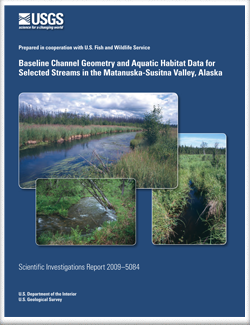 ABSTRACT ABSTRACT
Small streams in the rapidly developing Matanuska-Susitna Valley in south-central Alaska are known to support anadromous and resident fish but little is known about their hydrologic and riparian conditions, or their sensitivity to the rapid development of the area or climate variability. To help address this need, channel geometry and aquatic habitat data were collected in 2005 as a baseline of stream conditions for selected streams. Three streams were selected as representative of various stream types, and one drainage network, the Big Lake drainage basin, was selected for a systematic assessment. Streams in the Big Lake basin were drawn in a Geographic Information System (GIS), and 55 reaches along 16 miles of Meadow Creek and its primary tributary Little Meadow Creek were identified from orthoimagery and field observations on the basis of distinctive physical and habitat parameters, most commonly gradient, substrate, and vegetation. Data-collection methods for sites at the three representative reaches and the 55 systematically studied reaches consisted of a field survey of channel and flood-plain geometry and collection of 14 habitat attributes using published protocols or slight modifications. Width/depth and entrenchment ratios along the Meadow-Little Meadow Creek corridor were large and highly variable upstream of Parks Highway and lower and more consistent downstream of Parks Highway. Channel width was strongly correlated with distance, increasing downstream in a log-linear relation. Runs formed the most common habitat type, and instream vegetation dominated the habitat cover types, which collectively covered 53 percent of the channel. Gravel suitable for spawning covered isolated areas along Meadow Creek and about 29 percent of Little Meadow Creek. Broad wetlands were common along both streams. For a comprehensive assessment of small streams in the Mat-Su Valley, critical additional data needs include hydrologic, geologic and geomorphic, and biologic data, in particular the contribution of ground water and lakes to streamflow, water quality, flood plain connectivity, and surficial geology.
|
Part or all of this report is presented in Portable Document Format (PDF); the latest version of Adobe Reader or similar software is required to view it. Download the latest version of Adobe Reader, free of charge. |